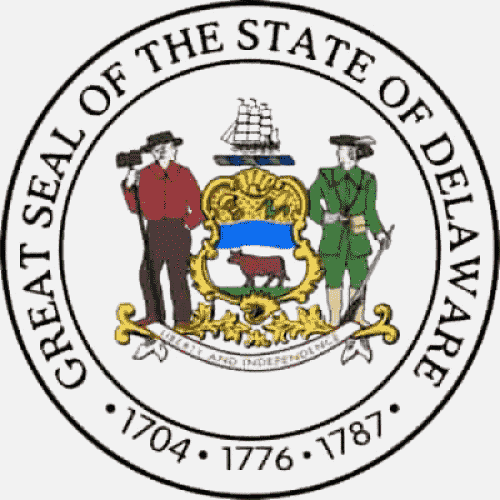 State Flag |  State Seal |
Delaware is a U.S. state located on the Atlantic Coast in the Mid-Atlantic region of the United States. It is bordered to the south and west by Maryland, to the northeast by New Jersey, and to the north by Pennsylvania.
- ABBREVIATION: DE
- NICKNAME: The First State
- POPULATION: 1,051,917 (2024 est.)
- CAPITAL: Dover
- STATE BIRD: Blue Hen Chicken
- STATE FLOWER: Peach Blossom
- AREA: 1,982 sq. mi.
- TIME ZONE: Eastern
- ENTERED UNION: Dec. 7, 1787
- ALTITUDE: High, 447 ft. Near the Ebright Azimuth Marker
- CLIMATE: Cool winters, hot summers; ample rainfall.
Delaware is on a level plain, with the lowest mean elevation of any state in the nation. Its highest elevation, located at Ebright Azimuth, near Concord High School, is less than 450 feet (140 m) above sea level. The northernmost part of the state is part of the Piedmont Plateau with hills and rolling surfaces.
The Atlantic Seaboard fall line approximately follows the Robert Kirkwood Highway between Newark and Wilmington; south of this road is the Atlantic Coastal Plain with flat, sandy, and, in some parts, swampy ground.
A ridge about 75 to 80 feet (23 to 24 m) high extends along the western boundary of the state and separates the watersheds that feed Delaware River and Bay to the east and the Chesapeake Bay to the west.

Blackbird Pond, New Castle County, Delaware
Delaware’s access to the sea and its routes to mineral-bearing areas inland through the Delaware River led to its early industrialization. The state still produces heavy machinery and primary metals, but most important is the chemical industry concentrated around Wilmington. Wilmington is called the “Chemical Capital of the World,” largely because of E. I. du Pont de Nemours and Co., a chemical industry giant.
Fun Facts:
- In 1880 the country held the first Miss United States pageant in Delaware. Inventor Thomas Edison was one of the judges.
- During the Revolutionary War, a company of soldiers under Captain Jonathan Caldwell amused themselves by staging cockfights with their captain’s blue hen chickens. The men distinguished themselves in several key battles and became known as the Blue Hen’s.
- Delaware is sometimes called the Diamond State. This nickname can be traced back to Thomas Jefferson, who called Delaware a jewel among states because of its strategic position along the Atlantic coast.
- Built by Swedish immigrants in 1683, Delaware is home to the first log cabins in North America, most of those ‘log cabins’ were a simple single-room, one story structure.
- A portion of the Delaware-Pennsylvania border is the only rounded boundary in the United States.
- Delaware’s nickname, First State, refers to the fact that it was the first state to ratify the U.S. Constitution.
History:
Delaware, though small in size, holds a significant place in American history as the first state to ratify the U.S. Constitution. Its story is one of Native American heritage, European colonization, colonial conflict, and early American leadership.
Before Europeans arrived, the land that is now Delaware was inhabited by Native American tribes, most notably the Lenape (also known as the Delaware) and the Nanticoke. These tribes lived in harmony with the region’s rivers, forests, and coastline, relying on hunting, fishing, and farming.
The first European to explore Delaware’s coast was Henry Hudson in 1609, followed by Samuel Argall in 1610. The Dutch were the first to attempt colonization in 1631, establishing a small settlement called Zwaanendael near present-day Lewes. However, conflict with Native Americans led to its destruction.
In 1638, Swedish settlers founded Fort Christina (now Wilmington), establishing the colony of New Sweden—the first permanent European settlement in Delaware. The Swedes introduced log cabin construction, which would become a symbol of the American frontier.
In 1655, the Dutch regained control of the area, but their rule was short-lived. In 1664, the British seized the Dutch colonies, including the Delaware region, and it became part of the English colonial empire.
Delaware was initially controlled by the Duke of York (later King James II) and then transferred to William Penn in 1682. Penn added Delaware to his Pennsylvania colony but allowed it to maintain its own assembly, creating a tradition of semi-independence.
By the 1700s, Delaware had grown into a prosperous area of farming, trade, and shipbuilding. Though technically under Pennsylvania’s governor, Delaware’s separate legislature allowed it to maintain a distinct identity. This dual structure continued until the American Revolution.
Delaware played an active role in the push for independence. Caesar Rodney, a delegate from Delaware, famously rode 80 miles through a thunderstorm to Philadelphia in July 1776 to cast a decisive vote for independence. Delawareans served in the Continental Army, and the state became known for its patriotism and commitment to liberty.
On December 7, 1787, Delaware made history by becoming the first state to ratify the U.S. Constitution, earning it the nickname “The First State.” Its early commitment to the new republic positioned it as a leader among the original thirteen colonies.
During the 19th century, Delaware’s economy was centered on agriculture and industry. The DuPont Company, founded in 1802 near Wilmington, became one of the world’s leading chemical manufacturers and played a significant role in Delaware’s development. Despite being a slave state, Delaware remained loyal to the Union during the Civil War, though it did not abolish slavery until the passage of the 13th Amendment.
In the 20th and 21st centuries, Delaware became known for its business-friendly laws and corporate headquarters, as well as its contributions to banking, manufacturing, and politics.
Today, Delaware’s rich history continues to shape its identity. From early European settlement to its role in founding the United States, Delaware’s legacy is one of independence, innovation, and enduring national significance.